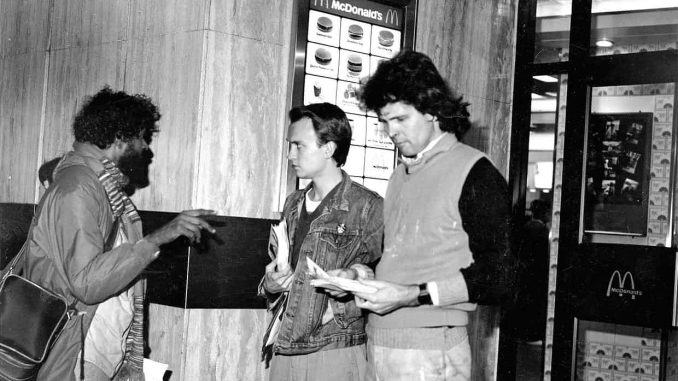
‘That’s me in the picture” which appears in the Guardian every Saturday featured the above photo of me and undercover cop Bob Lambert protesting outside McDonald’s. It was taken on 16 October 1986 – 31 years ago today – the first time the What’s Wrong with McDonald’s leaflet was distributed. Lambert was one of the authors and years later it would be the subject of McLibel, the longest running trial in English legal history. This is the story behind one of the most iconic spycops images.
I met Bob Lambert at my first London Greenpeace meeting in 1985, when I was in my early 20s. We got chatting about animal rights and quickly became friends; he was charismatic and like the older brother I never had. He was someone I could identify with; he was amiable, vegan and believed strongly in animal rights.
He’d drop little compliments. One that stands out was at a benefit gig for the Animal Liberation Front in September 1986, at a squat in Islington. I designed the poster and he said, “That looks great. You’re an artist!” I was flattered, and it stuck with me. I now know that spies are trained to tell you things you want to hear.
This photograph was taken on World Anti McDonald’s Day. We’d just published a new leaflet entitled What’s Wrong With McDonald’s: Everything They Don’t Want You To Know. I think I contributed one sentence: “Revolution begins in your stomach.” It was the leaflet that led to the McLibel trial – I was one of those sued by McDonald’s in 1990.
I apologised under duress: we were advised by a libel lawyer we had no chance of winning and would be made bankrupt without the case even getting to court. Needless to say, there is no way I’d have said sorry had I known Lambert was a spy.
A friend with a good SLR camera took pictures, to have a record of the demo. In this shot, we’re picketing McDonald’s on Oxford Street. There were about 10 of us, handing out leaflets and talking to people. Lambert’s staring down at the leaflet, almost as if he’s admiring his creation; he had a key role in producing it.
He disappeared two years later, at the end of 1988. For years he was a sort of folk-tale hero, the activist who had eluded the police. He’d been downbeat the last time I’d seen him, saying his father had just died and that he wasn’t allowed to see his own son. I now know both were lies.
In September 2011, I found out he was an undercover police officer for special branch, and had fathered a child with a fellow activist. It made me angry. He hadn’t just spied on me for years; he became a manager of the special demonstrations squad and trained others who also spied on me. He followed me from afar for more than two decades.
We were aware the state would take an interest in us, but no one guessed they would create fake people using dead children’s identities and become part of our personal lives. Now we say, “We were a bit naive”; but if you behave as if everyone’s a spy, you’d make yourself so unwelcoming to outsiders, you couldn’t make a group work.
If I saw Lambert again, I might hurl abuse at him, or I might ignore him. For more than 20 years, this was a private picture of someone I thought was a good friend, whom I missed. I would look at it from time to time and wonder about him. It’s strange that it’s now famous. It has been published widely online and in the book Undercover, about Britain’s secret police. When I look at it, I see an idealistic young man with someone he trusted. But he was a conman. He betrayed me. He used me, and others, to build his career.
It hasn’t tainted those values I had. If he had changed me in that way, then he would have won.
http://powerbase.info/index.php/Bob_Lambert
Leave a Reply